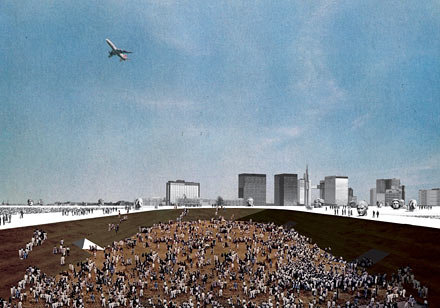A Vision for Brussels
dal 15/3/2007 al 15/9/2007
Segnalato da
15/3/2007
A Vision for Brussels
Bozar - Centre for Fine Arts, Bruxelles
Imagining the Capital of Europe. An international team of sixteen architects and urban designers enrolled at the Berlage Institute (Rotterdam) has been looking at a concrete project for Brussels as a worthy capital of Europe. The plan foresees the insertion into the city of a coherent ensemble of symbolic public buildings, urban functions, and new residential developments.

Imagining the Capital of Europe
Curators: Pier Vittorio Aureli and Joachim Declerck
This year Europe celebrates the fiftieth anniversary of the signing of the Treaty of Rome. This also marks, of course, the fiftieth anniversary of the European presence in Brussels. But is Brussels really the right place to develop the capital of Europe? So how can Brussels fulfil its European mission and express the European political project? What is the true nature of the European presence in Brussels? What picture of itself does Brussels present, or needs to present, to Europe and the world? An international team of sixteen architects and urban designers enrolled at the Berlage Institute (Rotterdam) has been looking at these questions since 2004. Their study has resulted in a concrete project for Brussels as a worthy capital of Europe. Starting on 16 March, this project will be presented to the public in the exhibition A Vision for Brussels - Imagining the Capital of Europe, which will be open until 20 May at the Centre for Fine Arts in Brussels. On 9 May, Europe Day, the Centre for Fine Arts will host an international symposium with the same title.
The timing is perfect: the fiftieth anniversary of the signing of the Treaty of Rome marks fifty years of an ongoing quest for a coherent European project for Brussels. An ideal time to look back, but also a time for conclusions and an opportunity to turn the spotlight on the city's future role as the European capital. A Vision for Brussels suggests that Brussels is the best possible place to develop the capital of Europe. With its multiple social, political, and cultural layers, the city perfectly reflects the diversity of today's Europe. Brussels is Europe in miniature. To talk about Brussels is to talk about Europe.
Both the project A Vision for Brussels and the exhibition of the same name take the obvious, hidden, or forgotten qualities of the city as the building blocks for a concrete urban project that has the relationship between the European institutions, the city, and its citizens at its heart. The plan foresees the insertion into the city of a coherent ensemble of symbolic public buildings, urban functions, and new residential developments - spread over nine strategic locations. The project aims to break through the isolation of the European presence in Brussels. New public spaces would emerge, where, for the first time, proximity and interaction between the citizen and the European institutions would become possible. Europe brings different peoples and cultures together; this European project for Brussels connects the different social, spatial, and cultural layers of the city with each other. This new urban form places the European questions on the agenda, engages in the public debate, and has the vigour to communicate its message - Brussels, Capital of Europe.
The project and the exhibition break through fixed ideas that see Brussels as the accidental capital of Europe and set out to make the often abstract discussion about the future of the capital of the European Union concrete, tangible, and accessible. A Vision for Brussels takes a polemical stand that will advance the current debate about the future of Brussels and Europe. It is no accident that the Berlage Institute is taking an interest in this issue. The institute is Europe's most renowned centre for postgraduate studies in architecture and urban planning. Every year, after undergoing a rigorous selection process, twenty-five architects from all over the world undertake research projects under the guidance of the elite of the European and international architectural scene. The team that looked into the future of Brussels is made up of architects from Spain, Italy, Germany, Greece, Belgium, Croatia, Canada, China, and Japan. The team worked under the direction of the Italian architecture tutor Pier Vittorio Aureli and of Elia Zenghelis from Greece, formerly a founding partner of Rem Koolhaas's Office for Metropolitan Architecture (OMA).
The exhibition at the Centre for Fine Arts is designed by the Brussels architectural practice Office Kersten Geers David Van Severen. These young architects made their mark with their winning competition entry for the design of the administrative capital of South Korea. Recently, they also won the architectural competition for the renovation of the Wiels arts centre in Brussels. The exhibition also offers an opportunity to see a short film by the VRT journalist Robin Ramaekers, which was made in collaboration with the Berlage Institute, Umberto Eco, François Schuiten, Geert van Istendael, and Guy Verhofstadt.
Contact:
Leen Daems Press Officer BOZAR EXPO & STUDIOS
02 5078389 +32 (0)479 986607 leen.daems@bozar.be
Opening: march 16, 2007
Bozart - Center of Fine Arts
Rue Ravenstein 23 - Brussels
Hours: 10-18
Free admission



